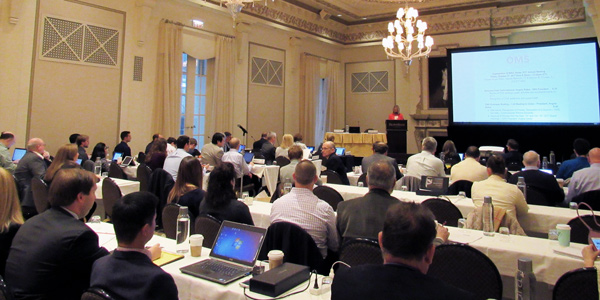A clean energy consultant told Midwest regulators Tuesday that a future footprint with more renewables would benefit from modern transmission technologies.
Rob Gramlich, president and founder of Grid Strategies, said transmission technologies — dynamic line ratings, flow control devices and network topology optimization — will help manage congestion.
“We’re looking at a future where there are a lot of low-cost but remote resources,” Gramlich told the Organization of MISO States’ Board of Directors at the National Association of Regulatory Utility Commissioners’ annual meeting.
Gramlich said the technologies have improved dramatically and are ready for use today, but they need to be better valued monetarily.
“They’re there and ready, but the incentives aren’t in place,” Gramlich said. “It’s just hard to get low-cost improvements because they can’t be rolled into transmission owners’ rate base. … There’s a gap that state regulators can address.”
Dynamic line ratings are adjusted based on weather conditions, opening up transmission lines for more capacity when temperatures are cooler. Network topology optimization uses software to improve scheduling of transmission outages. Gramlich also said power flow control devices, like phase angle regulators, played a key role in PJM managing loads during the early January bomb cyclone cold snap.
“Operate the existing grid more efficiently and get more out of it,” Gramlich urged.
He expressed surprise at how many line limit and flow thresholds on the bulk power system are not exactly known, only estimated. “It’s not so often measured,” Gramlich said.
It’s time for the industry to develop a technology-managed smart grid, he continued, noting that much of the country’s sewer flows are managed through technology.
Such technologies are more widely used abroad, where incentives are in place, Gramlich said, pointing to Belgium, which makes widespread use of dynamic line ratings.
OMS DER Survey Begins
The board kicked off an effort to collect data from load-serving entities on the volume of distributed energy resources participating in their service territories.
OMS will survey LSEs across MISO through March 30 on the current and projected state of DER in their territories. The group plans to analyze the data to get a better understanding of the “structure, scope and pace of DER development in MISO.”
The survey is part OMS’ ongoing initiative to help state and local regulators make informed decisions as increased DER adoption potentially dictates the need to develop policy around the interaction between distribution and transmission systems. Last year, OMS formed a temporary working group to formulate ideas on incorporating DER into the grid after holding a MISO-wide workshop. (See OMS Discusses Next Steps in DER Policy.)
“The OMS board has made DER a priority because of the inherent jurisdictional overlap raised by future integration of DER connected to the distribution system into transmission-level planning, operations, and energy markets,” OMS President, and chair of the Arkansas Public Service Commission, Ted Thomas said in a statement.
“In a multistate region, it’s critical that cooperation among states and their utilities occurs to provide the necessary visibility to DER deployment that enables the continued efficient and reliable operation of the bulk electric system,” said OMS Vice President Daniel Hall, chair of the Missouri Public Service Commission.
— Amanda Durish Cook




